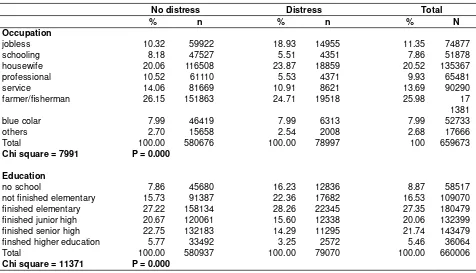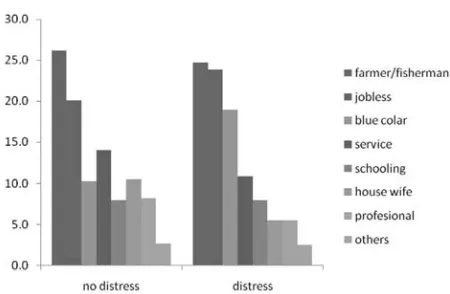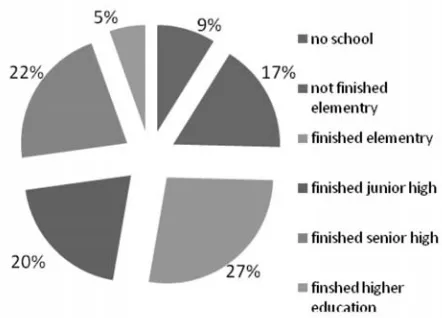ANALYSIS OF 2007 INDONESIAN BASIC HEALTH SURVEY
Siti Isfandari1
ABSTRACT
Background: It is well received that poor mental health can lead to social disparity and inequity indicated by unemployment and low education. However, the association between emotional distress with social disparity and in equity in population-based studies has not been well characterized. Using 2007 Riskesdas data, this analysis intend to examine reciprocal association between emotional distress with education and employment. Method: There were 659,672 respondents age above 14 in the survey which was carried out in the 33 provinces across Indonesia using probability proportion to size sample representing population until sub district level. First emotional distress is treated as risk for low education and employment. Then, emotional distress is treated as impact of - unemployment and low education. Four hypotheses are tested. Result: All the hypotheses confi rmed reciprocal relationship between emotional distress and social disparity. Integrative intervention among ministries is necessary to improve mental health status and alleviating disparity and in equity for Indonesian.
Key words: emotional distress, disparity and in equity, low education, unemployment, Indonesia
Naskah Masuk: 7 Oktober 2011, Review 1: 10 Oktober 2011, Review 2: 11 Oktober 2011, Naskah layak terbit: 31 Oktober 2011
1 Center of Humaniora, Health Policy and Community Empowerement Research, National Institiute of Health Research and Development,
address: percetakan negara 29 Jakarta. e-mail: ....
INTRODUCTION
Nowadays, disparities and inequity are quite hot issues in the world. Latest US health report addressed these issues focusing on various components of health disparities as result of social in-equity. The report informed social inequity as risk factors of the various health disparities. Mental health is among the components mentioned in the report (World Socialist Website, 2011).
The Ministry of Health Republic of Indonesia gives priority in 60 districts with sharp health disparity compared with other 300 districts. IPKM, the Indicator used for categorizing the disparities only give small weight to mental health indicator (Kementrian Kesehatan Indonesia, 2010). The reason is that there is no priority program in mental health As a result sub-districts with high prevalence of mental distress could be considered as have no serious health problems.
Still facing with classic, emerging and new emerging infectious disease, compounded by the raising of chronic disease due to the improvement
people health status, the government prefers putting lots of effort to control infectious disease, and maternal child health problems (Kementerian Kesehatan Indonesia, 2010). Perhaps controlling infectious disease through immunization or vaccination, or improving child and maternal health by deploying midwives and well trained health providers in the remote area have more clear indicators rather than puts the efforts to improve mental health status in the community. Partly since putting the effort in the mental health area will not guarantee clear evidence that could be used as development or measured indicators. Also, there is yet evidence that investing in mental health will be benefi cial.
METHODS
Variables used for analysis are education level, employment, mental distress. The analysis mainly explores association between mental distress with education and employment. This is a descriptive analysis using mostly chi square statistics technique. Respondents in the survey are representing Indonesian people until district level.Mental distress defi ned as person who had higher than 5 score in the Self Report Questionnaires. Only respondents age 15 or above fi lled in the questionnaires in the Riskesdas survey.
The analysis was performed under the assumption there was vicious association between mental distress with education and employment. Several hypotheses were tested for the analysis. The fi rst hypothesis is people with mental distress have lower proportion of high education and higher proportion of low education. Second hypothesis is people with the lowest education have highest proportion of mental distress. The third hypothesis is people with mental distress have higher proportion of unskilled occupation/jobless and lower proportion of skilled occupation. The last hypothesis is people without occupation have the highest proportion of mental distress.
To test the first and third hypothesis, mental distress was treated as risk factors for education and employment. While in other two hypotheses, mental distress was treated as result of education and employment.
RESULT
Among 659,672 respondents age above 14, 78996 had score higher than fi ve, meaning 12 out of 100 Indonesian age above 14 have emotional distress. Analysis result below show the education distribution proportion of people with mental distress compared with those without mental distress (fi gure 1), followed by description of proportion of mental distress based on educational level (fi gure 2).Then it is followed by distribution proportion of occupation among people with mental distress compared to those without mental distress (fi gure 3). The last fi gure show proportion of mental distress based on occupation (fi gure 4).
Association between mental distress, occupation and education.
Figure 1 shows different pattern on education attainment between no distress and having emotional
Table 1. Proportion of Occupation and Education Attainment between No Distress and Distress Group
No distress Distress Total
% n % n % N
Occupation
jobless 10.32 59922 18.93 14955 11.35 74877
schooling 8.18 47527 5.51 4351 7.86 51878
housewife 20.06 116508 23.87 18859 20.52 135367
professional 10.52 61110 5.53 4371 9.93 65481
service 14.06 81669 10.91 8621 13.69 90290
farmer/fi sherman 26.15 151863 24.71 19518 25.98 17
1381
blue colar 7.99 46419 7.99 6313 7.99 52733
others 2.70 15658 2.54 2008 2.68 17666
Total 100.00 580676 100.00 78997 100 659673
Chi square = 7991 P = 0.000
Education
no school 7.86 45680 16.23 12836 8.87 58517
not fi nished elementary 15.73 91387 22.36 17682 16.53 109070
fi nished elementary 27.22 158134 28.26 22345 27.35 180479
fi nished junior high 20.67 120061 15.60 12338 20.06 132399
fi nished senior high 22.75 132183 14.29 11295 21.74 143479
fi nshed higher education 5.77 33492 3.25 2572 5.46 36064
Total 100.00 580937 100.00 79070 100.00 660006
distress group. There is quite similar proportion of people who fi nished elementary school in both groups. The disparity begins to emerge in the unfinished elementary school category where there is clearly higher proportion in the emotional distress group. It is even sharper in the no school category. More contrast appears for higher education, where there is un-doubtfully higher proportion in people without emotional distress group compared in those with emotional distress. Figure 1 shows emotional distress could be risk factor for in-equity in education. It confi rmed the fi rst hypothesis.
Figure 2. Proportion of mental distress by education level
This second fi gure depicts highest proportion of mental distress is in the no school category, while the lowest proportion is in the highest education group. It points out that disparity in education could lead to higher emotional distress. This fi gure supports the second hypothesis.
Figure 3 depicts the proportion difference pattern of occupation between people with and without emotional distress. Ignoring farmer/fi sherman, the fi gure shows decreasing proportion as the occupation category moves from jobless, unskilled toward skilled occupation among the emotional distress group. Different pattern occurred in the people without distress. Proportion of jobless and unskilled occupation is higher in the people with emotional distress, while proportion of skilled occupation is higher in the people without emotional distress group. This figure implies that mental distress could lead to in-equity for occupation. It supports the third hypothesis.
Figure 4. Proportion of mental distress by occupation
The prominent meaning of the last figures illustrates jobless category has the highest proportion of emotional distress. Then is followed by sharp decrease when the person have some activities, either they are housewife, blue collar or other occupation including schooling. This fi gure support the hypothesis number 4, although except for fi sherman/farmer, there Figure 1. Proportion of education attainment by mental
is only a slight proportion differences of emotional distress between unskilled and skilled occupation.
To provide more meaningful interpretation of the above analysis, it is necessary to know the proportion of education and occupation of Indonesian.
Figure 5 illustrate the proportion of education reached by Indonesian age above 14. Highest proportion of people have fi nished elementary school, followed by fi nished senior and fi nished junior high. Only 9% of no schooling, unfortunately only 5% fi nished higher education.
Figure 6. Proportion of occupation, Riskesdas 2007
Figure 6 shows fi shermen/farmer and housewives are the highest proportion of occupation among the Indonesian, comprised almost 50% population. Schooling, service and professional could be categorized as skilled occupation comprises about
32% population, while proportion of blue collar workeris only 8%.
DISCUSSION
Analysis confirmed the assumption of vicious relationship between emotional distress with education and occupation. All hypotheses are supported. The most prominent variables associated with emotional distress are jobless and low education consists of no schooling and not fi nished elementary. The fact that housewives had quite high proportion of emotional distress is interesting although not surprising. Another interesting result is quite similar proportion between people with and without emotional distress in fi nished elementary school and in farmer/fi shermen category.
The close proportion of people with finished elementary education between people with and without emotional distress could be explained by national education program taken place since 25 years ago, that fi nishing elementary school is an obligation for all school age children. The sharp gap probably occurred in the older category was compensated by the cohort born in later years. Close proportion of farmers/fi sherman between people with and without emotional distress could be explained that it was the traditional occupation for Indonesian. It was a common profession, everybody engage in the occupation especially in non urban area.
There are lots of literatures explained the reason concerning the higher proportion of emotional distress among women. Among them are the multi role and tasks bore by women in this century.4 Most part in
Indonesia infl uenced by the patriarchal culture where placed man in higher status. Although modernization seemed already took place in several places, the culture still in the atmosphere in most places. The 2007 Susenas showed on average education level in women is better than men, but it seemed the philosophy of equal status between men and women still a long way to go. This refl ected by still small proportion of Indonesian women with high rank position either in the central government, not mention in provincial or lower level.
impact on social condition. Literatures showed war, poverty lessen school age children for education (Desjarlais R. et al.,1995). The relationship could be moderated by mental status of the children. This analysis showed although emotional status is indeed could be risk factors for disparity and in equity for education and occupation, but it did not impede person with the condition to reach the opportunity. It could be because for certain people the emotional distress they experienced could become a trigger for struggle to reach their goal. Although not as abundant as article supporting the assumption that in – equity or disparity in social condition lead to mental distress, several articles showed that mental distress could be risk factor of social in – equity or disparity (Wilson RS et al., 2007; Foss L et al., 2010; Dyrbye LN et al., 2004; Andrade LH et al., 2010; Antaramian SP, 2010).
Though mental health program has not yet as a priorityin the health policy, Indonesian government realized the importance of it. So to make service closer to the community, well trained mental health nurses will be deployed in primary health care. For early prevention, Government has launched hotline service for those who have emotional problem (Sinar Harapan, 2010; Cakrawala, 2009). Hopefully this program will help people to have better mental health status and health status in general.
CONCLUSION AND RECOMMENDATION
The analysis showed reciprocal association between mental health and social condition. Mental health could be either risk or impact of social inequity and disparity. Health sector could have signifi cant role in alleviating the imbalance by offering mental health program to the vulnerable group, especially the jobless, low education and housewives. The intervention should be in coordination with other sector such as Ministry of Workforce, Ministry of Education and Ministry of Women Empowerment.
DAFTAR PUSTAKA
Andrade LH, Benseñor IM, Viana MC, Andreoni S, Wang YP. 2010. Clustering of psychiatric and somatic
illnesses in the general population: multimorbidity and socioeconomic correlates. Braz J Med Biol Res. May; 43(5): 483–91. Epub 2010 Apr 2. Availabe at http:// www.ncbi.nlm.nih.gov/pubmed/20379689 Access in july 18th 2011
Antaramian SP, Scott Huebner E, Hills KJ, Valois RF. 2010. A dual-factor model of mental health: toward a more comprehensive understanding of youth functioning. Am J Orthopsychiatry. Oct; 80(4): 462–72. doi: 10.1111/j.1939-0025.2010.01049.x. Availabe at http:// www.ncbi.nlm.nih.gov/pubmed/20950287Access in july 18th 2011
Puskesmas Integrasikan LayananKesehatanJiwa, 2009. Cakrawala Rabu, 14 Oct, 16:27:30, http://www.pdpersi. co.id/?show=detailnews&kode=5222&tbl=cakrawala Desjarlais R, Eisenberg L, Good B, Kleinman A. 1995. World
Mental Health: problems & priorities in low income countries, Oxford University Press.
Dyrbye LN, Thomas MR, Power DV, Durning S, Moutier C, Massie FS Jr, Harper W, Eacker A, Szydlo DW, Sloan JA, Shanafelt TD. 2010. Burnout and serious thoughts of dropping out of medical school: a multi-institutional study. Acad Med. Jan; 85(1): 94–102. http://www.ncbi. nlm.nih.gov/pubmed/20042833
Foss L, Gravseth HM, Kristensen P, Claussen B, Mehlum IS, Skyberg K. 2010. Risk factors for long-term absence due to psychiatric sickness: a register-based 5-year follow-up from the Oslo health study. J Occup Environ Med. Jul; 52(7): 698–705. http://www.ncbi.nlm.nih.
gov/pubmed/20595908Access in July 18th 2011
Kementerian Kesehatan Indonesia. 2010. Indeks Pembangunan KesehatanMasyarakat
Kementrian Kesehatan RI, 2010, Rencana Strategis Kementrian Kesehatan Tahun 2010–2014
Sinar Harapan, Senin, 11 Oktober 2010 13:38 Hari Kesehatan Jiwa: Akses Pelayanan Kesehatan Jiwa Masih Minim Availabe at http://www.sinarharapan. co.id/cetak/berita/read/akses-pelayanan-kesehatan-jiwa-masih-minim accessed july 18th 2011
Wilson RS et al. 2007. “Chronic distress and incidence of mild cognitive impairment.”Neurology; 68: 2085–92.
World Socialist Website, Report documents widening US


